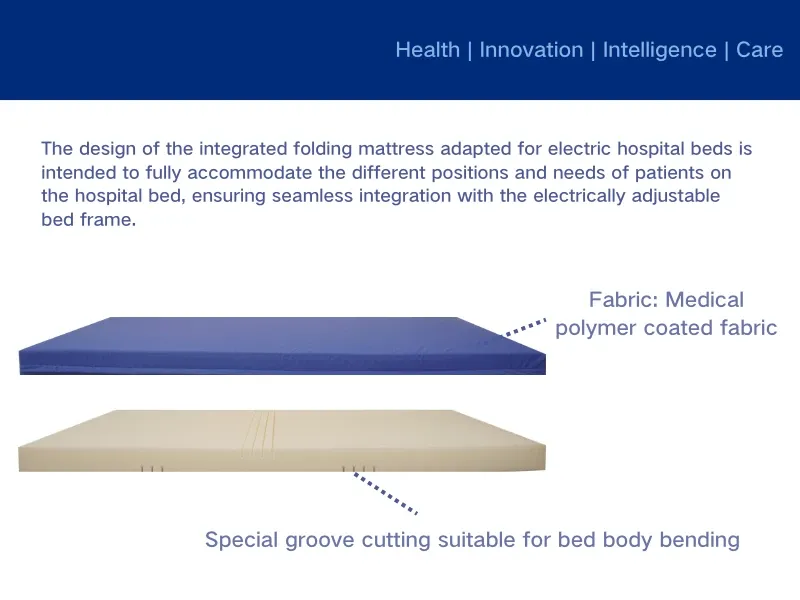The Role of Pressure Relieving Mattresses in Alleviating Pressure on Bony Prominences
Pressure ulcers, also known as bedsores or decubitus ulcers, are localized injuries to the skin and underlying tissue that typically occur over bony prominences due to prolonged pressure. These painful and potentially dangerous wounds commonly develop in individuals with limited mobility, such as elderly patients, those recovering from surgery, or people with spinal cord injuries. A pressure ulcer prevention mattress is specifically designed to mitigate this risk by redistributing pressure away from vulnerable areas, thereby enhancing blood circulation and reducing tissue damage.

Traditional mattresses often fail to provide adequate support, leading to concentrated pressure on areas like the heels, sacrum, hips, and elbows. Over time, this unrelieved pressure restricts blood flow, causing ischemia, tissue necrosis, and eventually ulcer formation. A pressure relief mattress addresses this issue by utilizing advanced materials and technologies that adapt to the body's contours, minimizing peak pressure points and promoting even weight distribution.
How a Pressure Relieving Mattress Works to Protect Bony Areas
The primary function of a pressure relieving mattress for pressure ulcers is to reduce interface pressure—the force exerted between the body and the mattress surface. These specialized mattresses employ various mechanisms to achieve this:
- Dynamic and Static Pressure Redistribution
Some pressure relief mattresses use alternating air cells that inflate and deflate in cycles, constantly shifting pressure points to prevent prolonged compression on any single area. This dynamic system is particularly beneficial for high-risk patients who are entirely bedridden.
Static pressure-relieving mattresses, on the other hand, rely on viscoelastic memory foam or gel-infused layers that conform to the body’s shape, providing consistent cushioning without the need for mechanical adjustments. These are ideal for patients who can make slight positional changes independently.
- Contouring Support for Vulnerable Bony Prominences
A well-designed mattress to relieve pressure points contours around bony protrusions rather than allowing them to bear the brunt of body weight. High-density foams and air-filled chambers work synergistically to cradle these areas, reducing shear forces and friction that contribute to skin breakdown.
For instance, the sacral region—one of the most common sites for pressure ulcers—benefits greatly from a mattress that provides deeper immersion without bottoming out. Similarly, heel pressure can be minimized through strategic zoning that offers extra cushioning where it’s needed most.
- Enhancing Microclimate Management
Excessive moisture and heat buildup can exacerbate skin vulnerability. Many pressure ulcer prevention mattresses incorporate breathable covers and moisture-wicking materials to maintain an optimal microclimate. By keeping the skin dry and cool, these mattresses further reduce the risk of maceration and subsequent ulcer formation.
Clinical Benefits of Using a Pressure Relieving Mattress
Reduction in Pressure Ulcer Incidence
Studies have shown that implementing a pressure relieving mattress in healthcare settings significantly lowers the incidence of pressure injuries. By ensuring that no single body part endures excessive pressure for extended periods, these mattresses help maintain tissue integrity.
Improved Comfort and Sleep Quality
Patients using a mattress to relieve pressure points often report better sleep due to reduced discomfort. The even distribution of weight alleviates pain in sensitive areas, making prolonged bed rest more tolerable.
Cost-Effectiveness in Long-Term Care
While specialized mattresses may have a higher upfront cost, they ultimately reduce healthcare expenses by preventing pressure ulcers, which require costly treatments such as wound care, antibiotics, and even surgical interventions in severe cases.
Choosing the Right Pressure Relief Mattress
When selecting a pressure relieving mattress for pressure ulcers, factors such as patient mobility, weight, and risk level must be considered. High-risk individuals may benefit from dynamic alternating pressure systems, whereas low-to-medium-risk patients might find static foam mattresses sufficient.
Additionally, maintenance and durability play crucial roles—mattresses with waterproof, anti-bacterial covers are preferable in clinical environments to ensure hygiene and longevity.
A pressure ulcer prevention mattress is a vital tool in safeguarding at-risk individuals from the debilitating effects of pressure injuries. By effectively redistributing pressure, enhancing blood flow, and maintaining skin health, these specialized mattresses play a crucial role in both clinical and home care settings. Investing in the right pressure relief mattress not only improves patient outcomes but also enhances overall quality of life for those with limited mobility.
-
Sleep Tracking Mattress Maintenance TipsसमाचारJul.22,2025
-
Mattress Wave Designs for People with ArthritisसमाचारJul.22,2025
-
Mattress for Back Pain and Spinal AlignmentसमाचारJul.22,2025
-
Hypoallergenic Properties of Silicone Gel MattressसमाचारJul.22,2025
-
How a Gel Memory Foam Mattress Regulates TemperatureसमाचारJul.22,2025
-
Doctors’ Recommendations on Special Mattress for Back PainसमाचारJul.22,2025
-
Customizing a Patient Bed Mattress for Specific NeedsसमाचारJul.22,2025

